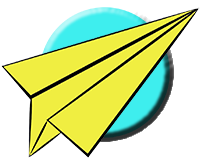Hickory Paper Airplane - How to Fold
Hickory Paper Airplane - How to Fold
Instructions
1. Fold the paper exactly in half about its long edge. Unfold after the crease has been made.
2. Fold the upper left corner down so the upper left point hits the center line crease. When folded correctly, the left half of the paper's top edge should line up with the center line crease.
3. Fold the upper right corner down so the upper right point hits the center line crease. When folded correctly, the right half of the paper's top edge should line up with the center line crease.
4. Flip the paper over keeping the nose towards the top.
5. Fold the point at the right edge of the paper over so it hits the center line crease. When folded correctly, the right diagonal edge of the paper should line up with the center line crease. Be sure to NOT fold the triangular flap underneath when making this fold.
6. Fold the point at the left edge of the paper over so it hits the center line crease. When folded correctly, the left diagonal edge of the paper should line up with the center line crease. Be sure to NOT fold the triangular flap underneath when making this fold.
7. Fold the tip of the nose down so the top point hits the center line crease at the point formed by the existing flaps.
8. Flip the plane over and rotate it around so the nose points to the right.
9. Fold the plane exactly in half about the existing center line crease.
10. Rotate the plane around so the nose points to the left and the bottom edge of the fuselage is down.
11. Make a crease for the first wing flap. The left point of the crease should be about one finger width up from the bottom edge of the fuselage and the right point should be about three finger widths up.
12. Flip the plane over so the first wing flap is underneath and the nose points to the right.
13. Make a crease for the second wing flap. Be sure to line up the wing flaps for good balance and flying characteristics.
14. Open up the wing flaps and adjust the wing angles so they are even. Set the dihedral angle flat or slightly up.
THE THROW Launch level or at a slight up angle with a moderate throw. This craft tends to float, but is an extremely versatile flyer and can be trimmed to do many different types of flight. Try a piece of tape to hold the sides together or adjust the canards way up or down for interesting flight variations.
